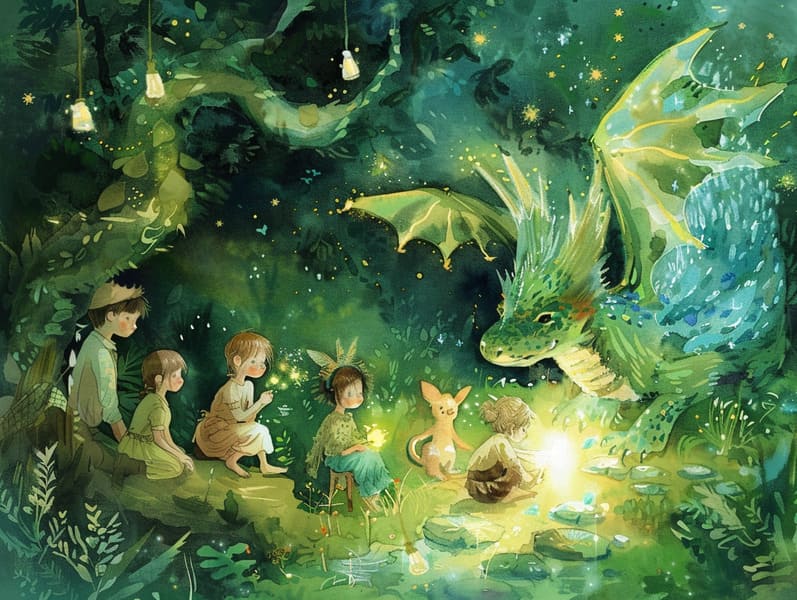
Children's fairy tales have long histories. These stories have been transmitted from one generation to the next millennia before they were ever written down. They emerged from a variety of traditions, including African traditions. They were initially told among grown-ups, often carrying themes and messages related to the societal norms and beliefs of the time.
The Brothers Grimm, Jacob and Wilhelm Grimm, were among the first to collect and release many of these beloved tales. Their volume, "Grimm's Story Collection," included classics like "The True Bride," "Hansel and Grethel," and "The True Story of Snow White," which have since become essentials in the world of timeless fairy tales. Similarly, Hans Andersen's enchanting fairy tales, such as "The Little Mermaid," and "The Duckling's Story," have enchanted hearts worldwide, ensuring their place in the pantheon of classic fairy tales.
Though they are centuries old, fairy tales remain as applicable as ever, especially as kids' bedtime tales. These whimsical stories are now available in diverse formats, including richly illustrated books, whimsical animations, and online storybooks.
Their ongoing significance can be linked to several magical reasons:
Moral Lessons: Old fairy tales often share important moral lessons. Tales like "The Wolf and the Liar" teach the merit of truthfulness, while "The Race of the Tortoise and the Hare" emphasize the virtues of persistence and unassuming nature. These narratives offer kids clear distinctions between good and bad, molding their moral compass in a gentle yet important way.
Empathy and Understanding: Timeless fairy tales frequently showcase individuals facing obstacles and hardships, inspiring audiences to comprehend with their struggles and back their triumphs. For instance, "Beauty and Her Beast" demonstrates the significance of looking past the exterior to recognize the inner spirit of a character, fostering warmth and perception.
Cultural Recognition: Many fairy tales are deeply ingrained in the cultural contexts from which they grew. Delving into these tales can provide enlightening views into different beliefs, building a sense of global understanding and awareness.
Fantasy and Imagination: The imaginative elements in old fairy tales—talking animals—kindle children’s inventiveness. These tales guide readers to imaginary realms, engendering creative thinking and a sense of marvel that lasts a lifetime.
Classic fairy tales are not only fantastical but also didactic. They work as entrancing tools in promoting various mental and emotional abilities in kids. When classic fairy tales are voiced, they foster communication skills by offering new lexicon and intricate sentence structures. This practice also promotes listening abilities and concentration, as the young keep up with the story, anxious to see what happens next.
Furthermore, debating the themes and characters of traditional fairy tales can enhance intellectual skills and problem-solving abilities. Kids are taught to notice patterns, predict happenings, and get cause and effect. These reflections also assist little ones utter their thoughts and feelings, advancing their emotional intelligence.
In today’s information age, the prevalence of digital storybooks has made these narratives more within reach than ever. Online resources and web apps present comprehensive collections of Grimm's fairy tales that can be read or listened via anytime, anywhere. Fairy tales narrated are particularly favored, supplying an engaging way for the young to take part in these fantastical tales. Narrated books and read-out-loud videos carry characters and settings to life, often supported by charming background sounds and songs that enhance the narrative experience.
The unending appeal of old fairy tales lies in their ability to alter to current eras while holding onto their basic principles. Contemporary revisions of these stories often bring in more inclusive protagonists and modern settings, making them pertinent to today’s audience. However, the underlying themes of heroism, sympathy, and lawfulness remain unchanged, continuing to appeal to audiences of all ages.
Fairy tales also offer a sense of calm and predictability. They grant a well-ordered narrative with a plain beginning, middle, and end, often ending with the solving of conflicts and the triumph of justice over injustice. This dependability can be calming for kids, gifting a sense of unchangeability in an shifting world.
Old fairy tales continue to charm and enlighten new generations, maintaining their splendor and impact in modern society. As nighttime stories for kids, they introduce a perfect blend of captivation and insight, sustaining moral values, empathy, and creativity. The proliferation of internet fairy tales and the prevalence of fairy tales recited ensure that these classic stories remain acquirable to new generations.
By continuing and spreading these fairy tales, we continue to treasure the rich tapestry of fables and cultural heritage. Whether you are reading a colorful picture book, experiencing a online library, or listening to an read-aloud book, the beauty of traditional fairy tales is always within reach. These stories point out of the perpetual influence of narratives and its ability to unite us across eras and regions.
If you are viewing a richly illustrated book, exploring a electronic collection, or playing an sound book, the majesty of popular fairy tales with morals Grimm's fairy tales is always within reach.
These narratives show us of the undying power of stories and its ability to tie us across time and space, forging a link that captivates and teaches alike.